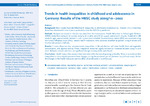Trends in health inequalities in childhood and adolescence in Germany: Results of the HBSC study 2009/10 – 2022
Moor, Irene
Herke, Max
Markert, Jenny
Böhm, Marie
Reiß, Franziska
Bilz, Ludwig
Sudeck, Gordon
Winter, Kristina
Background: Many studies have identified health inequalities in childhood and adolescence. However, it is unclear how these have developed in recent years, particularly since the COVID-19 pandemic.
Methods: Analyses are based on the German data from the international Health Behaviour in School-aged Children (HBSC) study from 2009/10 (n = 5,005), 2013/14 (n = 5,961), 2017/18 (n = 4,347), and 2022 (n = 6,475). A total of 21,788 students aged approximately between 11 and 15 years were included. Socioeconomic status (SES) was assessed using the Family Affluence Scale (FAS). Several health indicators were analysed stratified by gender using bivariate and multivariate analysis methods.
Results: In 2022, there are clear socioeconomic inequalities in life satisfaction, self-rated health, fruit and vegetable consumption, and physical activity. These inequalities remained largely constant or increased between 2009/10 and 2022. Between 2017/18 and 2022, no significant changes in inequalities were found.
Conclusions: Health inequalities are persistent and reduce the chances of growing up healthy. There is no evidence that inequalities in the analysed outcomes have changed during the pandemic period (between 2017/18 and 2022). Rather, the changes in the health indicators seem to affect all adolescents in a similar way.
Files in this item

